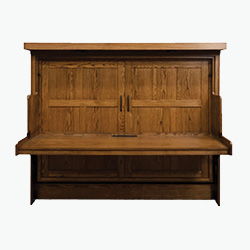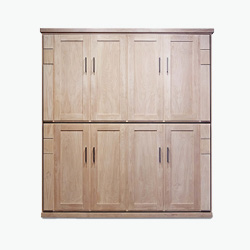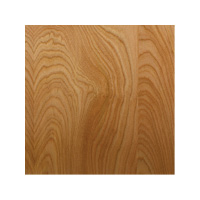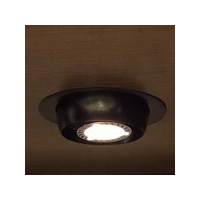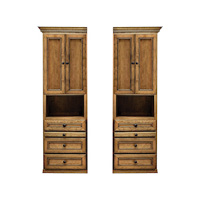Wilding Wallbeds is all about real wood. All materials are made exclusively out of hard wood and furniture grade ply. Wilding Wallbeds has worked directly with Sierra Forest Products to create a seven layered plywood designed to work specifically in Murphy Bed construction. Murphy Beds function differently from most household furniture. Most parts have to span longer distances and be able to stay straight and support significant weight. Just inside the outside layers of hardwood veneer are 2 layers of Medium-density fibreboard (MDF) that keep the boards straight. The internal 3 layers are plywood with the grain criss crossed for better strength. This combination of MDF and plywood improves support and protects against warping with changes in humidity.

The main thing to take from this is that all of the wood used by Wilding Wallbeds is real, and it is sustainably sourced from woodlands planted in the U.S. for the singular purpose of growing lumber [1]. The common wood choices offered by Wilding Wallbeds are Oak, Alder, Knotty Alder, Maple, Cherry, Rustic Cherry, and African Mahogany. Along with these woods you have the option of requesting others such as Walnut, Pine, Quarter Sawn Oak and other woods. Each of these woods have different characteristics and traits that are specific to that species. This article will go through and explain specific traits to help make you feel confident about your wood choice.
Oak Wood

Oak wood is commonly used in the construction of hardwood furniture, hardwood flooring and in barrels used in the aging of wines, sherry, brandy, Irish whiskey, Scotch whisky and Bourbon whiskey. Oak is used in furniture and flooring because of its density. It is extremely tough and durable. There are two types of oak wood used in furniture: Red Oak and White Oak. Wilding Wallbeds uses Red Oak.
Oak has a beautifully distinctive amount of grain that truly sets it apart from other woods. It is easily identifiable by its long curvy patterns of darker and lighter rings, with consistent small tick marks throughout. Wilding Wallbeds has the ability to stain oak wood from the traditional red tones to blonde, gray, brown or even dark tones. As stated earlier, oak has a distinctive amount of grain so when it is painted, the color is consistent but the wood grain is still visible. Hardwood is a commodity, so it is priced based on it availability. Right now oak is readily available because of the amount of oak trees planted on plantations 70 years ago. The availability allows Wilding Wallbeds to offer this beautiful traditional wood as their most economical option.
Alder Wood

Alder wood is commonly used in the construction of hardwood furniture and electric guitars, most notably those manufactured by the Fender Musical Instruments Corporation, which have been built with alder bodies since the 1950’s [2]. Alder wood is a hard wood, less dense than oak or maple, but still very durable. If you aren’t familiar with alder, then you may be familiar with birch wood. Alder is grown on the west coast, and birch is grown in the east, but they are both from the same birch family.
Alder wood is the most popular wood choice offered by Wilding Wallbeds. People tend to love alder because of its consistent tone, less prominent grain and lack of knots. It could be referred to as a chameleon wood because of its acceptance of stain it can be made to look like many other woods, but for less money. Alder is very easy to work with and is less prone to blowouts or chipping. Alder, like oak, is readily available and priced at the lower end of the pricing scale.
Knotty Alder Wood
Knotty alder is the same wood as alder, but it contains knots, small cracks and other rustic marks that don’t reduce the structural integrity of the finished product. Knotty alder is extremely popular and adds a little bit more personality to the beauty of alder wood. Alder and knotty alder are priced the same.
Cherry Wood

Cherry wood is often used in making furniture, paneling, flooring, doors, boat interiors, musical instruments, turnings and carvings. As noted, many of cherry’s uses are in a decorative setting. It is known for its relatively clean straight grain, with darker pockets of hardened sap. Cherry can vary in colors from blonde to darker streaks of grain patterns. Cherry is a high end wood that is absolutely gorgeous. Cherry is a hardwood, it is not as dense or heavy as oak or maple, but slightly more than alder or mahogany.
When people think of cherry often they assume that it will be red because the fruit it produces is red. Though there may be veins of red throughout the wood it has a wide spectrum of colors with the most prominent being blonde. Cherry wood is fairly easy to work with and accepts stains evenly and well. This means that you have the option to darken the wood and add different colors to highlight its natural beauty [3].
Rustic Cherry Wood
Rustic cherry is the same wood as cherry but it contains knots, small cracks, dried sap pockets, and other rustic marks that don’t reduce the structural integrity of the finished product. Rustic cherry is often used to highlight the natural features of the wood, and to create a feeling of antiquity. Rustic cherry is priced the same as cherry wood.
Mahogany Wood

Mahogany is commonly used in fine hardwood furniture, instruments, stereo headphones, and phonograph record cartridges. It is used in instruments like drums, guitars, violins, and grand pianos because the wood gives a warm sound. Mahogany is a hardwood, it is harder and more durable than oak, but softer than maple. Mahogany is used in many decorative settings because of the popularity and elegance of the wood.
Naturally, Mahogany is a darker wood, and it accepts stain very well. The grain is what makes mahogany truly unique. Similar to oak is has consistant little tick marks, or grain depressions, but different than oak it has straight vertical grain pattern that doesn’t loop or swirl. Because of these vertical patterns mahogany is often used in modern and contemporary designs. These simple designs allow the grain to be the main focus of the piece of furniture. With that in mind, mahogany is also used in traditional settings allowing the grain to compliment the intricacy of the craftsmanship [4]. Mahogany is generally priced similarly to cherry wood.
Making the Choice
Now is the time to choose which wood will fit your needs. Call toll free 866-877-7803 for free samples of the stained woods you are interested in. They will mail them out so you can compare the colors in person to help make your decision easier. No matter which species of wood you choose, know that you are getting the highest quality of furniture made from real wood and made in America!
Sources
- “Delivering the Difference”. Sierra Forest Products. Retrieved 10 November 2016.
- “What are the tonal differences on solid body guitars, between Alder, Ash, Poplar, Basswood, Mahogany and Maple?”. Fender. Retrieved 10 November 2016.
- “Cherry”. American Hardwood Information Center. Retrieved 10 November 2016.
- “7 Uses for Mahogany Wood”. Do It Yourself. Retrieved 10 November 2016.

